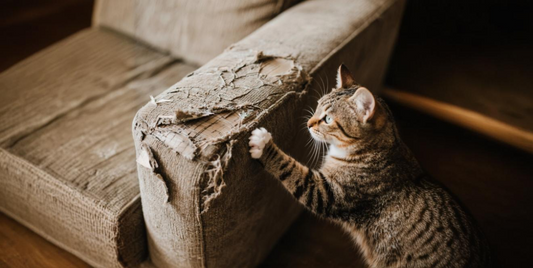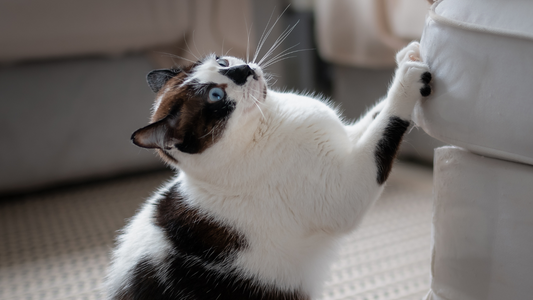Not all cats scratch the same way. Here’s how to pick a scratcher your cat will actually use.
One Size Doesn’t Fit All (Cats Are Picky!)
Choosing a cat scratcher might seem simple — until your cat ignores the one you picked. That’s because not all scratchers are created equal, and more importantly, not all cats scratch the same way. From posture and personality to texture and territory, multiple factors influence scratching behavior. Understanding your cat’s preferences will help you choose a scratcher they’ll actually use — and love. For a deeper look at how scratching style connects to personality and comfort, see Why Cats Scratch (and What Their Scratching Style Says About Them).
The Main Scratcher Styles Explained
Vertical Scratchers
- Mimic tree trunks in the wild, encouraging a full-body stretch.
- Ideal for confident cats who like to reach high, leave visible marks, and stretch upright.
- Work best in central or visible spaces — especially for cats who scratch furniture arms or door frames.
Hide & Scratch tip: If your cat is a vertical scratcher, try the upright Hide & Scratch Vertical Cat Scratcher Box near their favorite upright scratching spot.
Horizontal Scratchers
- Lay flat on the floor or in low-profile trays.
- Great for relaxed, low-energy cats, seniors, or those who scratch rugs and carpets.
- Allow cats to scratch while lying down or walking by casually.
Hide & Scratch tip: The spacious, low-profile Hide & Scratch Extra Large Cat Scratcher Box is perfect for horizontal scratchers.
Incline Scratchers
- Sloped scratchers offer a mix of vertical and horizontal engagement.
- Often attract playful, active cats who like to stretch at different angles.
- Ideal for cats that scratch the sides of stairs or lower sofa edges.
Multi-Function or Lounge-Style Scratchers
- Combine scratching with resting and hiding functions.
- Popular with cats who love boxes, cozy spots, or enclosed spaces.
- Great for homes with limited space or multiple cats.
Offering a mix of scratcher styles is often the best way to meet your cat’s needs and prevent boredom.
Personality Traits That Influence Scratching Style
- Territorial and confident cats often prefer vertical scratchers in highly visible areas so their scratch marks can be seen.
- Shy or anxious cats usually feel safer scratching in private. They may prefer low, horizontal, or enclosed options.
- Playful or high-energy cats benefit from incline scratchers or scratchers integrated into play structures.
- Older or arthritic cats may need easier access and softer textures — flat loungers or low-incline scratchers work well.
Watch how your cat already interacts with surfaces at home. If they scratch the couch, a vertical option nearby is a good substitute. If they claw the carpet, a flat pad is a better match.
The Role of Texture: What Feels Right Under the Claws
Scratchers come in a range of materials, each offering a different scratching sensation:
- Sisal rope or fabric: Tough and durable, offering resistance for deep claw engagement.
- Cardboard: Soft, shreddable, and satisfying for most cats — Hide & Scratch inserts use high-quality corrugated cardboard for maximum appeal.
- Carpet: Soft and familiar, though it may encourage scratching of household carpets.
Pro Tip: Offer multiple textures at first to learn your cat’s preference and reduce the chance of them returning to furniture.
Scratchers by Life Stage
- Kittens: Play-driven scratching is common. Introduce variety early to build good habits.
- Adult Cats: Often have established preferences. Make their favorite texture/angle more available.
- Seniors: May prefer soft cardboard or low-incline scratchers that don’t require full stretches.
Aging cats still need to scratch, so keep favorite spots accessible.
Where You Place the Scratcher Matters
Even the perfect scratcher can go unused if it’s hidden away. Try:
- Near favorite sleeping spots: Cats often stretch and scratch upon waking.
- By common scratching targets: If they’re already scratching the couch, place a scratcher nearby as an appealing alternative.
- In social areas: Cats often scratch in high-traffic zones to mark territory.
- Multiple locations: In multi-cat homes, give each cat a scratcher in their “zone.”
Avoid tucking scratchers into little-used corners. Integrate them into your cat’s usual pathways. If your goal is to replace couch scratching with a better option, practical redirection tips are in How to Stop Furniture Scratching — By Matching Your Cat’s Scratching Style.
Final Scratch: Let Your Cat Choose
You might need to try a couple of scratchers before you find the winner — and that’s okay! Pay attention to where your cat likes to scratch, how they position their body, and what textures they prefer. Once you spot a preference, stick with it — and place scratchers in multiple areas of your home to support healthy habits.
Conclusion: The Best Cat Scratcher Is the One Your Cat Will Actually Use
Finding the right scratcher isn’t about price — it’s about matching your cat’s style, personality, and texture preference. Whether they favor a vertical post, flat pad, incline design, or multi-function lounge, understanding their behavior is the key to making the right choice. For help applying these choices to real-life problem spots, check out How to Stop Furniture Scratching.





